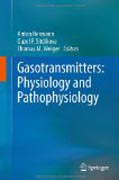
Gasotransmitters: physiology and pathophysiology
Hermann, Anton
Sitdikova, Guzel F.
Weiger, Thomas M.
Since the epochal discovery of the radical and highly toxic gas nitric oxide (NO) as a signaling molecule, two other no less toxic gases - carbon monoxide (CO) and hydrogen sulfide (H2S) - have been found to also be involved in a plethora of physiological and pathophysiological functions. The gases termed gasotransmitters play an increasingly important role in understanding how signalling into and between cells is modulated and fine-tuned. The advent of gasotransmitters has profoundly changed our way of thinking about biosynthesis, liberation, storage and action mechanisms in cellular signaling. In recent years an impressive amount of new data, distributed throughout the existing literature, has been generated. For this book the editors have recruited distinguished colleagues in the field to summarize and review important biological, pharmacological and medical functions and their implications, as well as methods for the detection of gasotransmitters. INDICE: 1 Nitric Oxide: Biological Synthesis and Functions.Ulrich Förstermann and Huige Li. .2 The Role of Carbon Monoxide as a Gasotransmitter in Cardiovascular and Metabolic Regulation.Ashley A. Untereiner, Lingyun Wu, and Rui Wang. .3 Physiological and Pathophysiological Functions of Hydrogen Sulfide.Hideo Kimura. .4 Methods for the Detection of Gasotransmitters.Hanjing Peng, Weixuan Chen, and Binghe Wang. .5 Gasotransmitters in Regulation of Neuromuscular Transmission.Guzel F. Sitdikova and Andrey L. Zefirov. .6 Modulated by Gasotransmitters - BK Channels.Anton Hermann, Guzel F. Sitdikova, and Thomas M. Weiger.
- ISBN: 978-3-642-30337-1
- Editorial: Springer
- Encuadernacion: Cartoné
- Fecha Publicación: 31/07/2012
- Nº Volúmenes: 1
- Idioma: Inglés
